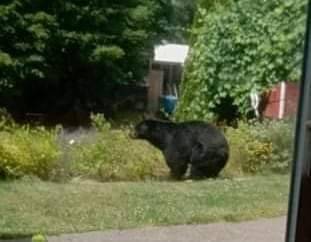A state official has changed his tune about the existence of a bear who scared a teenager and left behind a pile of berry-laden excrement on South Whidbey.
Ralph Downes, a state Department of Fish and Wildlife enforcement officer, was initially skeptical about the claim, but a photo circulating on a Whidbey community Facebook page convinced him that a black bear visited South Whidbey for what might be the first time in 50 years.
The photo, which was reportedly taken near Deer Lake in Clinton, shows a slightly plump black bear that appears to be sniffing around a backyard, mere feet away from a patio table and chairs.
“Assuming no one’s doing a Photoshop trick, that picture of that bear is real,” Downes said.
The photo was shared on social media Saturday morning. As of press time, Downes said he hasn’t heard any other reports of a bear in the area since then.
A teenage girl reported to the South Whidbey Record that she saw a bear-shaped animal on Aug. 3 while jogging and couldn’t believe her eyes. A few days earlier, on July 30, a Langley resident reported finding bear scat and sent a photograph to the department.
Downes confirmed last week that the poop could belong to a bear, but at the time suggested it may be more likely to belong to a coyote. But he also suggested that the suspicious pile might coincide with sightings of a young male black bear on Fidalgo Island.
After reviewing the reports and looking at the photographs, Downes said he now believes the bear on South Whidbey is real, but isn’t the same one spotted near Anacortes. The Fidalgo bear appears to be younger. It was last seen near Campbell Lake Aug. 3, just four days after the South Whidbey droppings were found.
“The Whidbey bear is a little chunkier,” Downes said. “I don’t know if he’s older, but he’s certainly better fed.”
He surmised that the two bears are young males “both doing what teenage boys do,” which means searching for companionship and snacking along the way. Downes pointed to the approaching black bear mating season as the reason the bears may have roamed so far from their usual homes in the forested areas of the mainland.
“I don’t think this is the beginning of a bear (living) on Whidbey,” Downes said. “I think he’s just passing through and looking for some stuff. I think he’s going to get tired of it and scram.”
There is no plan in place currently to trap and relocate the wandering Whidbey bear, but if his behavior were to take a turn for the worse that could change.
Right now, Downes said the lone ursid is remaining out of sight, which may be why there haven’t been more sightings or more photographs of him.
Over the past 50 years, Downes hasn’t been aware of any other bears on South Whidbey. Two years ago, a bear came to Whidbey Island on a similar quest for a mate but did not travel farther south than the Coupeville area.
Downes speculated that the occurrences of young males making the swim over from the mainland could be due to a statewide increase of the bear population. Citizens of the state voted in favor of an initiative in 1996 that banned private hunters from using bait, hounds or traps to kill bears.
Instructors from the Center for Wildlife Studies, a nonprofit organization promoting wildlife conservation and education, advised that people who encounter a black bear should not feed it. If it becomes “food conditioned” and familiar with humans, then that could result in a dangerous bear.
“A black bear is not inherently dangerous, but people shouldn’t get themselves in a position where they are very close, as the bear might get nervous and swat,” said Dave Garshelis, one of the nonprofit’s instructors.



